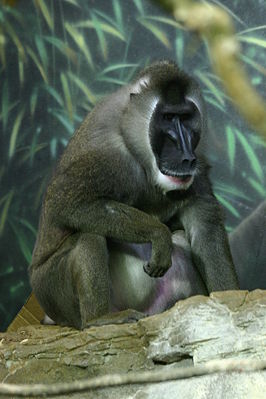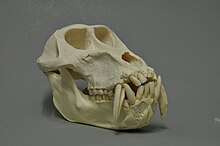Drill (primacy)
| drill | ||||||||||||
|---|---|---|---|---|---|---|---|---|---|---|---|---|

Drill ( Mandrillus leucophaeus ) |
||||||||||||
| Systematics | ||||||||||||
|
||||||||||||
| Scientific name | ||||||||||||
| Mandrillus leucophaeus | ||||||||||||
| ( Cuvier , 1807) |
The Drill ( Mandrillus leucophaeus ) is a primate of the family Cercopithecidae . Together with the mandrill it forms the genus of the mandrill-like ( mandrillus ).
description
The drill is similar to the mandrill, but does not have the bright color of the face. Its hairless face is black, has an elongated muzzle and bone furrows that run along the nose. It is also surrounded by a wreath of white hair. The rest of the body is hairy dark brown to black, with the exception of the bare buttocks area, which is colored red or blue. Drills are a little smaller than mandrills (around 70 centimeters in length and a maximum of 20 kilograms in body weight), with the males being almost twice as heavy as the females. The tail is just a stub 5 to 7 centimeters long.
distribution and habitat
Drills live in the region of the Cross River in Nigeria and around the Bakossi Mountains to the Sanaga River in Cameroon and on the island of Bioko , part of Equatorial Guinea , where they form their own subspecies, Mandrillus leucophaeus poensis . Their habitat is exclusively forests.
Way of life
Drills are diurnal rainforest inhabitants who are rarely found outside the protection of the dense vegetation. They live primarily on the ground, where they move on all fours; only females with young sometimes seek shelter in the lower branches of the trees. Drills live in groups of around 25 animals, which consist of a male, several females and their young. Several groups often come together to form associations that can include 200 or more animals. For communication, they use postures (for example, presenting the glowing rear part) as well as a series of shouts, which can be used to establish contact with other group members, to warn about predators or to gather the group together by the male.
food
Drills are omnivores that look for food almost exclusively on the ground. These include fruits, nuts, mushrooms, insects, and the occasional small vertebrate.
Reproduction
Little is known about the reproduction of the drills. The fertility of the female is indicated by discoloration of the anal region, which can turn bright red or blue. The gestation period is 6 months. As with most monkey relatives, a single cub is born.
Threat and Conservation
The main reasons for the threat to the drill are the hunt for the coveted bushmeat and the clearing of the rainforests to obtain tropical wood and arable land. Since drills live exclusively in the rainforest and behave shyly towards people, they are particularly threatened. The drill is considered one of the rarest African primates and it is estimated that only around 3,000 of these animals live in the wild. Wildlife sanctuaries that are home to the drill include Cross River National Park , Afi Mountain Wildlife Sanctuary , Mbe Mountains Community Wildlife Sanctuary in Nigeria, and Korup and Takamanda National Park in Cameroon, but survival remains in question. The IUCN lists the species as endangered ; it is listed in CITES Appendix I.
In 2007 a total of 272 drills were reported to the ISIS zoo database . An international stud book has been kept within the framework of the WAZA World Zoo Association since 1982 . The European zoo association EAZA also looks after the species in its European Conservation Breeding Program (EEP). The studbook currently has 77 zoo specimens worldwide. Around 150 specimens live in the Drill Rehabilitation Center in the Afi Mountains, Nigeria. In 1996, Liza Gadsby , co-founder of the Pandrillus organization , received the Whitley Award for her work to protect and preserve the species. A German organization that was founded specifically for the protection of the drill is the Nordhorn- based association Rettet den Drill e. V.
literature
- RN Nowak: Walker's Mammals of the World. Johns Hopkins University Press, 1999, ISBN 0-8018-5789-9 .
- A. Blom, MPT Alers, ATC Feistner, RFW Barnes, KL Barnes: Primates in Gabon - current status and distribution. In: Oryx. Volume 26, No. 4, 1992, pp. 223-234.
- TM Butynski, SH Koster: Distribution and conservation status of primates in Bioko Island, Equatorial Guinea. In: Biodiversity Conservation. Volume 3, No. 9, 1994, pp. 893-909.
- JF Oates: The distribution of Cercopithecus monkeys in West African forests. In: A. Gautier-Hion, F. Bourlière, J. Gautier, J. Kingdon (Eds.): A Primate Radiation: Evolutionary Biology of the African Guenons . Cambridge University Press, New York 1988, pp. 79-103.
- JF Oates: African Primates Status Survey and Conservation Action plan . IUCN / SSC Primate Specialist Group, 1996.
Individual evidence
- ↑ Drill (Mandrillus leucophaeus). ( Memento from July 14, 2015 in the Internet Archive ) on ARKIVE
- ↑ Afi Mountain Wildlife Sanctuary - Conservation of Nigeria's Drills Withley Fund of Nature (English)
- ↑ Website Rettet den Drill e. V.
- ↑ Pandrillus and Rettet den Drill eV ( Memento from December 12, 2013 in the Internet Archive ) (PDF; 1.3 MB) Tiergarten circular (German)
Web links
- Information and photos on arkive.org
- WAZA data sheet
- Information at theprimata.com
- Mandrillus leucophaeus in the endangered Red List species the IUCN 2006. Posted by: Butynski et al , 2000. Retrieved on 6 May, 2006.

